SN 2023ixf: The Closest Supernova of the Decade
Abstract
1. Discovery
2. Spectroscopic Properties
2.1. CSM Interaction Phase
2.2. Photospheric Phase
2.3. Nebular Phase
3. Photometric Properties
4. X-Ray Observations
5. Radio Observations
6. Neutrinos, -Rays, and Gravitational Waves
7. Progenitor System
7.1. Pre-Explosion Imaging
7.2. Light Curve and Spectral Modeling
7.3. CSM Structure and Mass Loss Mechanisms
8. Conclusions
Funding
Data Availability Statement
Acknowledgments
Conflicts of Interest
References
- Itagaki, K. Transient Discovery Report for 2023-05-19. In Transient Name Server Discovery Report; 2023; Volume 2023-1158, p. 1. [Google Scholar]
- Riess, A.G.; Yuan, W.; Macri, L.M.; Scolnic, D.; Brout, D.; Casertano, S.; Jones, D.O.; Murakami, Y.; Anand, G.S.; Breuval, L.; et al. A Comprehensive Measurement of the Local Value of the Hubble Constant with 1 km s−1 Mpc−1 Uncertainty from the Hubble Space Telescope and the SH0ES Team. ApJL 2022, 934, L7. [Google Scholar] [CrossRef]
- Perley, D.A.; Gal-Yam, A.; Irani, I.; Zimmerman, E. LT Classification of SN 2023ixf as a Type II Supernova in M101. Transient Name Serv. AstroNote 2023, 119, 1. [Google Scholar]
- Sgro, L.A.; Esposito, T.M.; Blaclard, G.; Gomez, S.; Marchis, F.; Filippenko, A.V.; Peluso, D.O.; Lawrence, S.S.; Verveen, A.; Wagner, A.; et al. Photometry of Type II Supernova SN 2023ixf with a Worldwide Citizen Science Network. Res. Notes Am. Astron. Soc. 2023, 7, 141. [Google Scholar] [CrossRef]
- Mao, Y.; Zhang, M.; Cai, G.; Chen, J.; Chen, J.; Gao, X.; Li, K.; Lyu, X.; Qin, Y.; Sun, G.; et al. Onset of SN 2023ixf observed over East Asian longitudes. Transient Name Serv. AstroNote 2023, 130, 1. [Google Scholar]
- Li, G.; Hu, M.; Li, W.; Yang, Y.; Wang, X.; Yan, S.; Hu, L.; Zhang, J.; Mao, Y.; Riise, H.; et al. A shock flash breaking out of a dusty red supergiant. Nature 2024, 627, 754–758. [Google Scholar] [CrossRef]
- Hosseinzadeh, G.; Farah, J.; Shrestha, M.; Sand, D.J.; Dong, Y.; Brown, P.J.; Bostroem, K.A.; Valenti, S.; Jha, S.W.; Andrews, J.E.; et al. Shock Cooling and Possible Precursor Emission in the Early Light Curve of the Type II SN 2023ixf. ApJL 2023, 953, L16. [Google Scholar] [CrossRef]
- Jacobson-Galán, W.V.; Dessart, L.; Margutti, R.; Chornock, R.; Foley, R.J.; Kilpatrick, C.D.; Jones, D.O.; Taggart, K.; Angus, C.R.; Bhattacharjee, S.; et al. SN 2023ixf in Messier 101: Photo-ionization of Dense, Close-in Circumstellar Material in a Nearby Type II Supernova. ApJL 2023, 954, L42. [Google Scholar] [CrossRef]
- Bostroem, K.A.; Pearson, J.; Shrestha, M.; Sand, D.J.; Valenti, S.; Jha, S.W.; Andrews, J.E.; Smith, N.; Terreran, G.; Green, E.; et al. Early Spectroscopy and Dense Circumstellar Medium Interaction in SN 2023ixf. ApJL 2023, 956, L5. [Google Scholar] [CrossRef]
- Teja, R.S.; Singh, A.; Basu, J.; Anupama, G.C.; Sahu, D.K.; Dutta, A.; Swain, V.; Nakaoka, T.; Pathak, U.; Bhalerao, V.; et al. Far-ultraviolet to Near-infrared Observations of SN 2023ixf: A High-energy Explosion Engulfed in Complex Circumstellar Material. ApJL 2023, 954, L12. [Google Scholar] [CrossRef]
- Zhang, J.; Lin, H.; Wang, X.; Zhao, Z.; Li, L.; Liu, J.; Yan, S.; Xiang, D.; Wang, H.; Bai, J. Circumstellar material ejected violently by a massive star immediately before its death. Sci. Bull. 2023, 68, 2548–2554. [Google Scholar] [CrossRef]
- Gal-Yam, A.; Arcavi, I.; Ofek, E.O.; Ben-Ami, S.; Cenko, S.B.; Kasliwal, M.M.; Cao, Y.; Yaron, O.; Tal, D.; Silverman, J.M.; et al. A Wolf-Rayet-like progenitor of SN 2013cu from spectral observations of a stellar wind. Nature 2014, 509, 471–474. [Google Scholar] [CrossRef] [PubMed]
- Yaron, O.; Perley, D.A.; Gal-Yam, A.; Groh, J.H.; Horesh, A.; Ofek, E.O.; Kulkarni, S.R.; Sollerman, J.; Fransson, C.; Rubin, A.; et al. Confined dense circumstellar material surrounding a regular type II supernova. Nat. Phys. 2017, 13, 510–517. [Google Scholar] [CrossRef]
- Dessart, L.; John Hillier, D.; Audit, E. Explosion of red-supergiant stars: Influence of the atmospheric structure on shock breakout and early-time supernova radiation. A&A 2017, 605, A83. [Google Scholar] [CrossRef]
- Khazov, D.; Yaron, O.; Gal-Yam, A.; Manulis, I.; Rubin, A.; Kulkarni, S.R.; Arcavi, I.; Kasliwal, M.M.; Ofek, E.O.; Cao, Y.; et al. Flash Spectroscopy: Emission Lines from the Ionized Circumstellar Material around <10-day-old Type II Supernovae. ApJ 2016, 818, 3. [Google Scholar] [CrossRef]
- Bruch, R.J.; Gal-Yam, A.; Schulze, S.; Yaron, O.; Yang, Y.; Soumagnac, M.; Rigault, M.; Strotjohann, N.L.; Ofek, E.; Sollerman, J.; et al. A Large Fraction of Hydrogen-rich Supernova Progenitors Experience Elevated Mass Loss Shortly Prior to Explosion. ApJ 2021, 912, 46. [Google Scholar] [CrossRef]
- Bruch, R.J.; Gal-Yam, A.; Yaron, O.; Chen, P.; Strotjohann, N.L.; Irani, I.; Zimmerman, E.; Schulze, S.; Yang, Y.; Kim, Y.L.; et al. The Prevalence and Influence of Circumstellar Material around Hydrogen-rich Supernova Progenitors. ApJ 2023, 952, 119. [Google Scholar] [CrossRef]
- Chugai, N.N. Broad emission lines from the opaque electron-scattering environment of SN 1998S. MNRAS 2001, 326, 1448–1454. [Google Scholar] [CrossRef]
- Huang, C.; Chevalier, R.A. Electron scattering wings on lines in interacting supernovae. MNRAS 2018, 475, 1261–1273. [Google Scholar] [CrossRef]
- Dessart, L. Probing red supergiant atmospheres and winds with early-time, high-cadence, high-resolution type II supernova spectra. A&A 2025, 694, A132. [Google Scholar] [CrossRef]
- Dickinson, D.; Milisavljevic, D.; Garretson, B.; Dessart, L.; Margutti, R.; Chornock, R.; Subrayan, B.; Hillier, D.J.; Golub, E.; Li, D.; et al. The Immediate, Exemplary, and Fleeting Echelle Spectroscopy of SN 2023ixf: Monitoring Acceleration of Slow Progenitor Circumstellar Material Driven by Shock Interaction. ApJ 2025, 984, 71. [Google Scholar] [CrossRef]
- Shivvers, I.; Groh, J.H.; Mauerhan, J.C.; Fox, O.D.; Leonard, D.C.; Filippenko, A.V. Early Emission from the Type IIn Supernova 1998S at High Resolution. ApJ 2015, 806, 213. [Google Scholar] [CrossRef]
- Smith, N. Interacting Supernovae: Types IIn and Ibn. In Handbook of Supernovae; Alsabti, A.W., Murdin, P., Eds.; Springer: Cham, Switzerland, 2017; p. 403. [Google Scholar] [CrossRef]
- Smith, N.; Pearson, J.; Sand, D.J.; Ilyin, I.; Bostroem, K.A.; Hosseinzadeh, G.; Shrestha, M. High-resolution Spectroscopy of SN 2023ixf’s First Week: Engulfing the Asymmetric Circumstellar Material. ApJ 2023, 956, 46. [Google Scholar] [CrossRef]
- Vasylyev, S.S.; Yang, Y.; Filippenko, A.V.; Patra, K.C.; Brink, T.G.; Wang, L.; Chornock, R.; Margutti, R.; Gates, E.L.; Burgasser, A.J.; et al. Early Time Spectropolarimetry of the Aspherical Type II Supernova SN 2023ixf. ApJL 2023, 955, L37. [Google Scholar] [CrossRef]
- Vasylyev, S.S.; Dessart, L.; Yang, Y.; Filippenko, A.V.; Patra, K.C.; Brink, T.G.; Wang, L.; Chornock, R.; Margutti, R.; Gates, E.L.; et al. Spectropolarimetric Evolution of SN 2023ixf: An Asymmetric Explosion in a Confined Aspherical Circumstellar Medium. arXiv 2025, arXiv:2505.03975. [Google Scholar] [CrossRef]
- Jacobson-Galán, W.V.; Dessart, L.; Davis, K.W.; Kilpatrick, C.D.; Margutti, R.; Foley, R.J.; Chornock, R.; Terreran, G.; Hiramatsu, D.; Newsome, M.; et al. Final Moments. II. Observational Properties and Physical Modeling of Circumstellar-material-interacting Type II Supernovae. ApJ 2024, 970, 189. [Google Scholar] [CrossRef]
- Yamanaka, M.; Fujii, M.; Nagayama, T. Bright Type II supernova 2023ixf in M 101: A quick analysis of the early-stage spectra and near-infrared light curves. PASJ 2023, 75, L27–L31. [Google Scholar] [CrossRef]
- Zimmerman, E.A.; Irani, I.; Chen, P.; Gal-Yam, A.; Schulze, S.; Perley, D.A.; Sollerman, J.; Filippenko, A.V.; Shenar, T.; Yaron, O.; et al. The complex circumstellar environment of supernova 2023ixf. Nature 2024, 627, 759–762. [Google Scholar] [CrossRef]
- Dessart, L.; Jacobson-Galán, W.V. Using spectral modeling to break light-curve degeneracies of type II supernovae interacting with circumstellar material. A&A 2023, 677, A105. [Google Scholar] [CrossRef]
- Jacobson-Galán, W.V.; Davis, K.W.; Kilpatrick, C.D.; Dessart, L.; Margutti, R.; Chornock, R.; Foley, R.J.; Arunachalam, P.; Auchettl, K.; Bom, C.R.; et al. SN 2024ggi in NGC 3621: Rising Ionization in a Nearby, Circumstellar-material-interacting Type II Supernova. ApJ 2024, 972, 177. [Google Scholar] [CrossRef]
- Zhang, J.; Li, C.K.; Cheng, H.Q.; Wu, Q.Y.; Jia, S.M.; Chen, Y.; Cui, W.W.; Feng, H.; Guan, J.; Han, D.W.; et al. SN 2024ggi: Detection of X-ray emission by EP-FXT. Astron. Telegr. 2024, 16588, 1. [Google Scholar]
- Kulkarni, S.R.; Harrison, F.A.; Grefenstette, B.W.; Earnshaw, H.P.; Andreoni, I.; Berg, D.A.; Bloom, J.S.; Cenko, S.B.; Chornock, R.; Christiansen, J.L.; et al. Science with the Ultraviolet Explorer (UVEX). arXiv 2021, arXiv:2111.15608. [Google Scholar] [CrossRef]
- Singh, A.; Teja, R.S.; Moriya, T.J.; Maeda, K.; Kawabata, K.S.; Tanaka, M.; Imazawa, R.; Nakaoka, T.; Gangopadhyay, A.; Yamanaka, M.; et al. Unravelling the Asphericities in the Explosion and Multifaceted Circumstellar Matter of SN 2023ixf. ApJ 2024, 975, 132. [Google Scholar] [CrossRef]
- Chugai, N.N.; Chevalier, R.A.; Utrobin, V.P. Optical Signatures of Circumstellar Interaction in Type IIP Supernovae. ApJ 2007, 662, 1136–1147. [Google Scholar] [CrossRef]
- Dessart, L.; Hillier, D.J. Modeling the signatures of interaction in Type II supernovae: UV emission, high-velocity features, broad-boxy profiles. A&A 2022, 660, L9. [Google Scholar] [CrossRef]
- Zheng, W.; Dessart, L.; Filippenko, A.V.; Yang, Y.; Brink, T.G.; De Jaeger, T.; Vasylyev, S.S.; Van Dyk, S.D.; Patra, K.C.; Jacobson-Galan, W.V.; et al. SN 2023ixf in the Pinwheel Galaxy M101: From Shock Breakout to the Nebular Phase. arXiv 2025, arXiv:2503.13974. [Google Scholar] [CrossRef]
- Bostroem, K.A.; Sand, D.J.; Dessart, L.; Smith, N.; Jha, S.W.; Valenti, S.; Andrews, J.E.; Dong, Y.; Filippenko, A.V.; Gomez, S.; et al. Circumstellar Interaction in the Ultraviolet Spectra of SN 2023ixf 14–66 Days After Explosion. ApJL 2024, 973, L47. [Google Scholar] [CrossRef]
- Shrestha, M.; DeSoto, S.; Sand, D.J.; Williams, G.G.; Hoffman, J.L.; Smith, P.S.; McCall, C.; Maund, J.R.; Steele, I.A.; Wiersema, K.; et al. Spectropolarimetry of SN 2023ixf Reveals Both Circumstellar Material and an Aspherical Helium Core. ApJL 2025, 982, L32. [Google Scholar] [CrossRef]
- Fang, Q.; Moriya, T.J.; Ferrari, L.; Maeda, K.; Folatelli, G.; Ertini, K.Y.; Kuncarayakti, H.; Andrews, J.E.; Matsumoto, T. Diversity in Hydrogen-rich Envelope Mass of Type II Supernovae. II. SN 2023ixf as Explosion of Partially Stripped Intermediate Massive Star. ApJ 2025, 978, 36. [Google Scholar] [CrossRef]
- Kumar, A.; Dastidar, R.; Maund, J.R.; Singleton, A.J.; Sun, N.C. Signatures of the shock interaction as an additional power source in the nebular spectra of SN 2023ixf. MNRAS 2025, 538, 659–670. [Google Scholar] [CrossRef]
- Folatelli, G.; Ferrari, L.; Ertini, K.; Kuncarayakti, H.; Maeda, K. SN 2023ixf: Interaction signatures in the spectrum at 445 days. arXiv 2025, arXiv:2502.10534. [Google Scholar] [CrossRef]
- Michel, P.D.; Mazzali, P.A.; Perley, D.A.; Hinds, K.R.; Wise, J.L. The nebular spectra of SN 2023ixf: A lower mass, partially stripped progenitor may be the result of binary interaction. MNRAS 2025, 539, 633–649. [Google Scholar] [CrossRef]
- Shrestha, M.; Pearson, J.; Wyatt, S.; Sand, D.J.; Hosseinzadeh, G.; Bostroem, K.A.; Andrews, J.E.; Dong, Y.; Hoang, E.; Janzen, D.; et al. Evidence of Weak Circumstellar Medium Interaction in the Type II SN 2023axu. ApJ 2024, 961, 247. [Google Scholar] [CrossRef]
- Van Dyk, S.D.; Szalai, T.; Cutri, R.M.; Kirkpatrick, J.D.; Grillmair, C.J.; Fajardo-Acosta, S.B.; Masiero, J.R.; Mainzer, A.K.; Gelino, C.R.; Vinkó, J.; et al. NEOWISE-R Caught the Luminous SN 2023ixf in Messier 101. ApJ 2024, 977, 98. [Google Scholar] [CrossRef]
- Hinds, K.R.; Perley, D.; Sollerman, J.; Miller, A.; Fremling, C.; Moriya, T.; Das, K.; Qin, Y.J.; Bellm, E.; Chen, X.T.; et al. Inferring CSM Properties of Type II SNe Using a Magnitude-Limited ZTF Sample. arXiv, 2025; arXiv:2503.19969. [Google Scholar] [CrossRef]
- Yang, Y.P.; Liu, X.; Pan, Y.; Er, X.; Liu, D.; Fang, Y.; Du, G.; Cai, Y.; Xu, X.; Chen, X.; et al. Multiband Simultaneous Photometry of Type II SN 2023ixf with Mephisto and the Twin 50 cm Telescopes. ApJ 2024, 969, 126. [Google Scholar] [CrossRef]
- Hsu, B.; Smith, N.; Goldberg, J.A.; Bostroem, K.A.; Hosseinzadeh, G.; Sand, D.J.; Pearson, J.; Hiramatsu, D.; Andrews, J.E.; Beasor, E.R.; et al. One Year of SN 2023ixf: Breaking Through the Degenerate Parameter Space in Light-Curve Models with Pulsating Progenitors. arXiv 2024, arXiv:2408.07874. [Google Scholar] [CrossRef]
- Forde, S.; Goldberg, J.A. Modeling Supernova 2023ixf: Lightcurve Degeneracies and Morphological Differences. arXiv 2025, arXiv:2504.12421. [Google Scholar] [CrossRef]
- Li, G.; Wang, X.; Yang, Y.; Pastorello, A.; Reguitti, A.; Valerin, G.; Ochner, P.; Cai, Y.; Iijima, T.; Munari, U.; et al. Optical and Near-infrared Observations of SN 2023ixf for over 600 days after the Explosion. arXiv 2025, arXiv:2504.03856. [Google Scholar] [CrossRef]
- Grefenstette, B.W.; Brightman, M.; Earnshaw, H.P.; Harrison, F.A.; Margutti, R. Early Hard X-Rays from the Nearby Core-collapse Supernova SN 2023ixf. ApJL 2023, 952, L3. [Google Scholar] [CrossRef]
- Chandra, P.; Chevalier, R.A.; Maeda, K.; Ray, A.K.; Nayana, A.J. Chandra’s Insights into SN 2023ixf. ApJL 2024, 963, L4. [Google Scholar] [CrossRef]
- Panjkov, S.; Auchettl, K.; Shappee, B.J.; Do, A.; Lopez, L.; Beacom, J.F. Probing the soft X-ray properties and multi-wavelength variability of SN2023ixf and its progenitor. PASA 2024, 41, e059. [Google Scholar] [CrossRef]
- Nayana, A.J.; Margutti, R.; Wiston, E.; Chornock, R.; Campana, S.; Laskar, T.; Murase, K.; Krips, M.; Migliori, G.; Tsuna, D.; et al. Dinosaur in a Haystack: X-Ray View of the Entrails of SN 2023ixf and the Radio Afterglow of Its Interaction with the Medium Spawned by the Progenitor Star (Paper I). ApJ 2025, 985, 51. [Google Scholar] [CrossRef]
- Berger, E.; Keating, G.K.; Margutti, R.; Maeda, K.; Alexander, K.D.; Cendes, Y.; Eftekhari, T.; Gurwell, M.; Hiramatsu, D.; Ho, A.Y.Q.; et al. Millimeter Observations of the Type II SN 2023ixf: Constraints on the Proximate Circumstellar Medium. ApJL 2023, 951, L31. [Google Scholar] [CrossRef]
- Matthews, D.; Margutti, R.; Alexander, K.D.; Bright, J.; Cendes, Y.; Berger, E.; Lasker, T.; Drout, M.; Milisavljevic, D. VLA 10 GHz Observations of SN2023ixf. Transient Name Serv. AstroNote 2023, 146, 1. [Google Scholar]
- Timmerman, R.; Arias, M.; Botteon, A. LOFAR Non-detections of SN 2023ixf in its First Year Post-explosion. Res. Notes Am. Astron. Soc. 2024, 8, 311. [Google Scholar] [CrossRef]
- Iwata, Y.; Akimoto, M.; Matsuoka, T.; Maeda, K.; Yonekura, Y.; Tominaga, N.; Moriya, T.J.; Fujisawa, K.; Niinuma, K.; Yoon, S.C.; et al. Radio Follow-up Observations of SN 2023ixf by Japanese and Korean Very Long Baseline Interferometers. ApJ 2025, 978, 138. [Google Scholar] [CrossRef]
- Lee, D.; Lee, S.Y.; Paragi, Z.; Orosz, G.; Oh, J.; Kim, J.Y. EVN 5 GHz e-VLBI Observations of SN2023ixf in M101. Res. Notes Am. Astron. Soc. 2024, 8, 121. [Google Scholar] [CrossRef]
- Martí-Devesa, G.; Cheung, C.C.; Di Lalla, N.; Renaud, M.; Principe, G.; Omodei, N.; Acero, F. Early-time γ-ray constraints on cosmic-ray acceleration in the core-collapse SN 2023ixf with the Fermi Large Area Telescope. A&A 2024, 686, A254. [Google Scholar] [CrossRef]
- Guetta, D.; Langella, A.; Gagliardini, S.; Della Valle, M. Low- and High-energy Neutrinos from SN 2023ixf in M101. ApJL 2023, 955, L9. [Google Scholar] [CrossRef]
- Sarmah, P. New constraints on the gamma-ray and high energy neutrino fluxes from the circumstellar interaction of SN 2023ixf. JCAP 2024, 2024, 083. [Google Scholar] [CrossRef]
- Kimura, S.S.; Moriya, T.J. High-energy Gamma-Ray and Neutrino Emissions from Interacting Supernovae Based on Radiation Hydrodynamic Simulations: A Case of SN 2023ixf. ApJ 2025, 984, 103. [Google Scholar] [CrossRef]
- Ravensburg, E.; Carenza, P.; Eckner, C.; Goobar, A. Constraining MeV-scale axionlike particles with Fermi-LAT observations of SN 2023ixf. PRD 2024, 109, 023018. [Google Scholar] [CrossRef]
- Cosentino, S.P.; Pumo, M.L.; Cherubini, S. High-Energy Neutrinos by Hydrogen-rich Supernovae interacting with low-massive Circumstellar Medium: The Case of SN 2023ixf. MNRAS 2025, 540, 2894–2913. [Google Scholar] [CrossRef]
- Abac, A.G.; Abbott, R.; Abouelfettouh, I.; Acernese, F.; Ackley, K.; Adhicary, S.; Adhikari, N.; Adhikari, R.X.; Adkins, V.K.; Agarwal, D.; et al. Search for Gravitational Waves Emitted from SN 2023ixf. ApJ 2025, 985, 183. [Google Scholar] [CrossRef]
- Kilpatrick, C.D.; Foley, R.J.; Jacobson-Galán, W.V.; Piro, A.L.; Smartt, S.J.; Drout, M.R.; Gagliano, A.; Gall, C.; Hjorth, J.; Jones, D.O.; et al. SN 2023ixf in Messier 101: A Variable Red Supergiant as the Progenitor Candidate to a Type II Supernova. ApJL 2023, 952, L23. [Google Scholar] [CrossRef]
- Jencson, J.E.; Pearson, J.; Beasor, E.R.; Lau, R.M.; Andrews, J.E.; Bostroem, K.A.; Dong, Y.; Engesser, M.; Gomez, S.; Guolo, M.; et al. A Luminous Red Supergiant and Dusty Long-period Variable Progenitor for SN 2023ixf. ApJL 2023, 952, L30. [Google Scholar] [CrossRef]
- Niu, Z.; Sun, N.C.; Maund, J.R.; Zhang, Y.; Zhao, R.; Liu, J. The Dusty Red Supergiant Progenitor and the Local Environment of the Type II SN 2023ixf in M101. ApJL 2023, 955, L15. [Google Scholar] [CrossRef]
- Soraisam, M.D.; Szalai, T.; Van Dyk, S.D.; Andrews, J.E.; Srinivasan, S.; Chun, S.H.; Matheson, T.; Scicluna, P.; Vasquez-Torres, D.A. The SN 2023ixf Progenitor in M101. I. Infrared Variability. ApJ 2023, 957, 64. [Google Scholar] [CrossRef]
- Van Dyk, S.D.; Srinivasan, S.; Andrews, J.E.; Soraisam, M.; Szalai, T.; Howell, S.B.; Isaacson, H.; Matheson, T.; Petigura, E.; Scicluna, P.; et al. The SN 2023ixf Progenitor in M101. II. Properties. ApJ 2024, 968, 27. [Google Scholar] [CrossRef]
- Qin, Y.J.; Zhang, K.; Bloom, J.; Sollerman, J.; Zimmerman, E.A.; Irani, I.; Schulze, S.; Gal-Yam, A.; Kasliwal, M.; Coughlin, M.W.; et al. The progenitor star of SN 2023ixf: A massive red supergiant with enhanced, episodic pre-supernova mass loss. MNRAS 2024, 534, 271–280. [Google Scholar] [CrossRef]
- Pledger, J.L.; Shara, M.M. Possible Detection of the Progenitor of the Type II Supernova SN 2023ixf. ApJL 2023, 953, L14. [Google Scholar] [CrossRef]
- Xiang, D.; Mo, J.; Wang, L.; Wang, X.; Zhang, J.; Lin, H.; Wang, L. The dusty and extremely red progenitor of the type II supernova 2023ixf in Messier 101. Sci. China Physics Mech. Astron. 2024, 67, 219514. [Google Scholar] [CrossRef]
- Ransome, C.L.; Villar, V.A.; Tartaglia, A.; Gonzalez, S.J.; Jacobson-Galán, W.V.; Kilpatrick, C.D.; Margutti, R.; Foley, R.J.; Grayling, M.; Ni, Y.Q.; et al. SN 2023ixf in Messier 101: The Twilight Years of the Progenitor as Seen by Pan-STARRS. ApJ 2024, 965, 93. [Google Scholar] [CrossRef]
- Jacobson-Galán, W.V.; Dessart, L.; Jones, D.O.; Margutti, R.; Coppejans, D.L.; Dimitriadis, G.; Foley, R.J.; Kilpatrick, C.D.; Matthews, D.J.; Rest, S.; et al. Final Moments. I. Precursor Emission, Envelope Inflation, and Enhanced Mass Loss Preceding the Luminous Type II Supernova 2020tlf. ApJ 2022, 924, 15. [Google Scholar] [CrossRef]
- Strotjohann, N.L.; Ofek, E.O.; Gal-Yam, A.; Bruch, R.; Schulze, S.; Shaviv, N.; Sollerman, J.; Filippenko, A.V.; Yaron, O.; Fremling, C.; et al. Bright, Months-long Stellar Outbursts Announce the Explosion of Interaction-powered Supernovae. ApJ 2021, 907, 99. [Google Scholar] [CrossRef]
- Neustadt, J.M.M.; Kochanek, C.S.; Smith, M.R. Constraints on pre-SN outbursts from the progenitor of SN 2023ixf using the large binocular telescope. MNRAS 2024, 527, 5366–5373. [Google Scholar] [CrossRef]
- Dong, Y.; Sand, D.J.; Valenti, S.; Bostroem, K.A.; Andrews, J.E.; Hosseinzadeh, G.; Hoang, E.; Janzen, D.; Jencson, J.E.; Lundquist, M.; et al. A Comprehensive Optical Search for Pre-explosion Outbursts from the Quiescent Progenitor of SN 2023ixf. ApJ 2023, 957, 28. [Google Scholar] [CrossRef]
- Rest, S.; Rest, A.; Kilpatrick, C.D.; Jencson, J.E.; von Coelln, S.; Strolger, L.; Smartt, S.; Anderson, J.P.; Clocchiatti, A.; Coulter, D.A.; et al. ATClean: A Novel Method for Detecting Low-luminosity Transients and Application to Pre-explosion Counterparts from SN 2023ixf. ApJ 2025, 979, 114. [Google Scholar] [CrossRef]
- Flinner, N.; Tucker, M.A.; Beacom, J.F.; Shappee, B.J. No UV-bright Eruptions from SN 2023ixf in GALEX Imaging 15-20 yr Before Explosion. Res. Notes Am. Astron. Soc. 2023, 7, 174. [Google Scholar] [CrossRef]
- Bersten, M.C.; Orellana, M.; Folatelli, G.; Martinez, L.; Piccirilli, M.P.; Regna, T.; Román Aguilar, L.M.; Ertini, K. The progenitor of SN 2023ixf from hydrodynamical modeling. A&A 2024, 681, L18. [Google Scholar] [CrossRef]
- Moriya, T.J.; Singh, A. Progenitor and explosion properties of SN 2023ixf estimated based on a light-curve model grid of Type II supernovae. PASJ 2024, 76, 1050–1058. [Google Scholar] [CrossRef]
- Jerkstrand, A.; Smartt, S.J.; Fraser, M.; Fransson, C.; Sollerman, J.; Taddia, F.; Kotak, R. The nebular spectra of SN 2012aw and constraints on stellar nucleosynthesis from oxygen emission lines. MNRAS 2014, 439, 3694–3703. [Google Scholar] [CrossRef]
- Dessart, L.; Hillier, D.J.; Sukhbold, T.; Woosley, S.; Janka, H.T. The explosion of 9–29M⊙ stars as Type II supernovae: Results from radiative-transfer modeling at one year after explosion. arXiv 2021, arXiv:2105.13029. [Google Scholar] [CrossRef]
- Ferrari, L.; Folatelli, G.; Ertini, K.; Kuncarayakti, H.; Andrews, J.E. Progenitor mass and ejecta asymmetry of supernova 2023ixf from nebular spectroscopy. A&A 2024, 687, L20. [Google Scholar] [CrossRef]
- Jacobson-Galán, W.V.; Dessart, L.; Davis, K.W.; Bostroem, K.A.; Kilpatrick, C.D.; Margutti, R.; Filippenko, A.V.; Foley, R.J.; Chornock, R.; Terreran, G.; et al. Final Moments III: Explosion Properties and Progenitor Constraints of CSM-Interacting Type II Supernovae. arXiv 2025, arXiv:2505.04698. [Google Scholar] [CrossRef]
- Martinez, L.; Bersten, M.C.; Folatelli, G.; Orellana, M.; Ertini, K. Circumstellar interaction models for the early bolometric light curve of SN 2023ixf. A&A 2024, 683, A154. [Google Scholar] [CrossRef]
- Hu, M.; Wang, L.; Wang, X. A Shock Crashing into Confined Dense Circumstellar Matter Brightens the Nascent SN 2023ixf. ApJ 2025, 984, 44. [Google Scholar] [CrossRef]
- Hiramatsu, D.; Tsuna, D.; Berger, E.; Itagaki, K.; Goldberg, J.A.; Gomez, S.; Kishalay, D.; Hosseinzadeh, G.; Bostroem, K.A.; Brown, P.J.; et al. From Discovery to the First Month of the Type II Supernova 2023ixf: High and Variable Mass Loss in the Final Year before Explosion. ApJL 2023, 955, L8. [Google Scholar] [CrossRef]
- Kozyreva, A.; Caputo, A.; Baklanov, P.; Mironov, A.; Janka, H.T. SN 2023ixf: An average-energy explosion with circumstellar medium and a precursor. A&A 2025, 694, A319. [Google Scholar] [CrossRef]
- Fuller, J.; Tsuna, D. Boil-off of red supergiants: Mass loss and type II-P supernovae. arXiv 2024, arXiv:2405.21049. [Google Scholar] [CrossRef]
- Soker, N. A Pre-explosion Effervescent Zone for the Circumstellar Material in SN 2023ixf. Res. Astron. Astrophys. 2023, 23, 081002. [Google Scholar] [CrossRef]
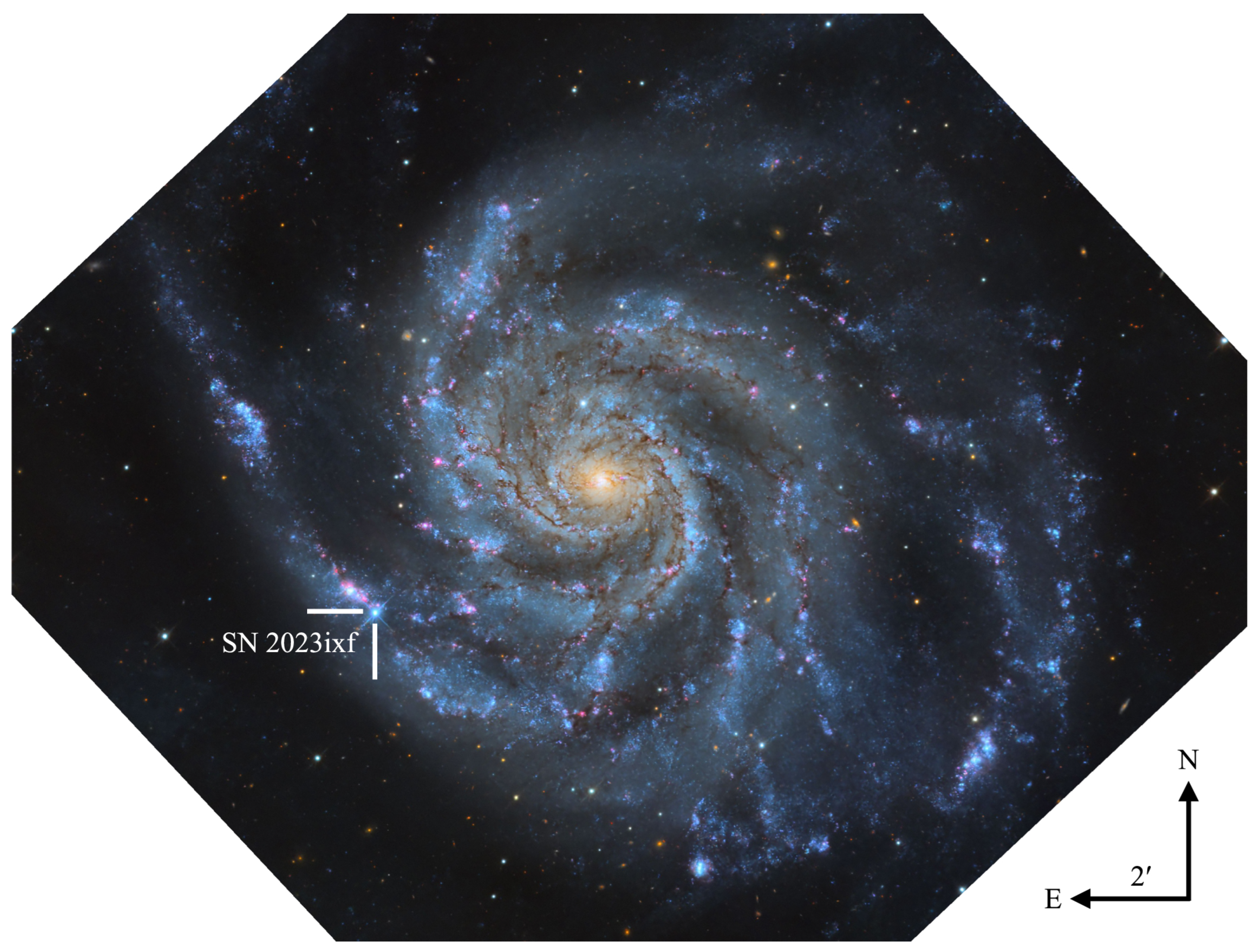


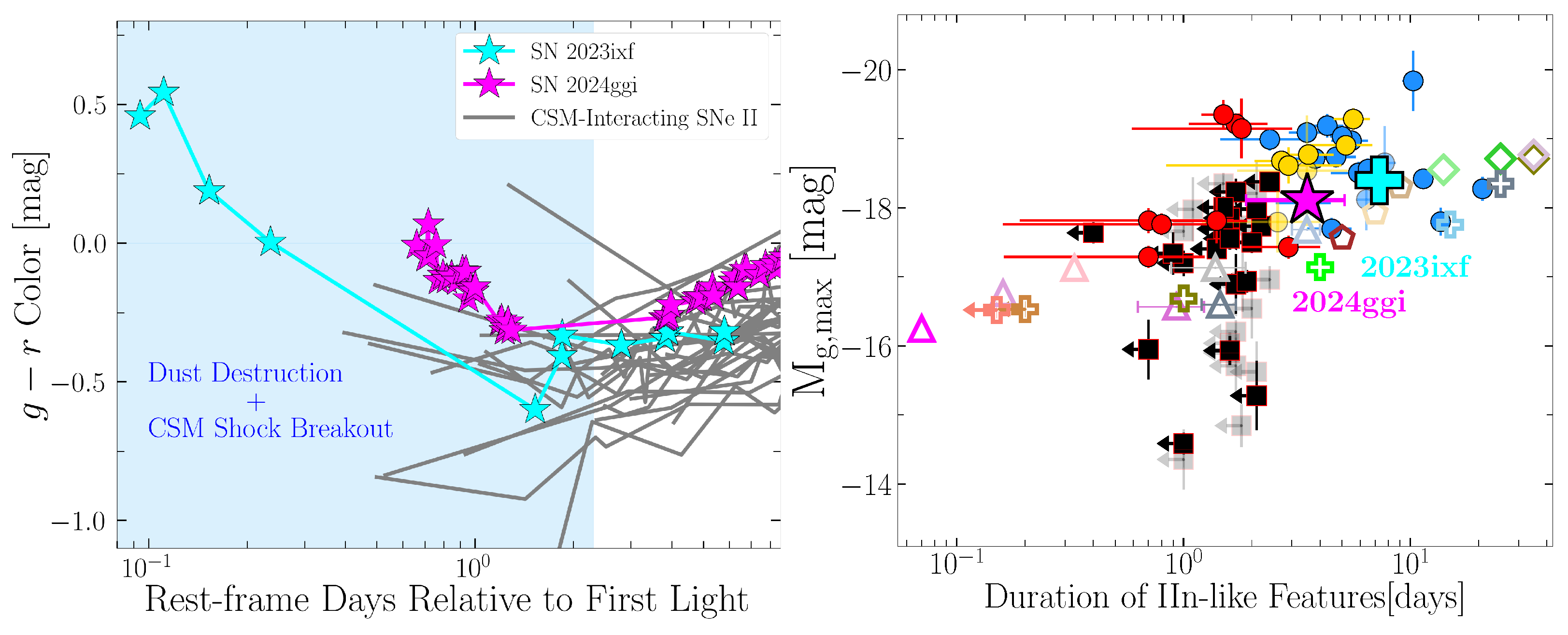
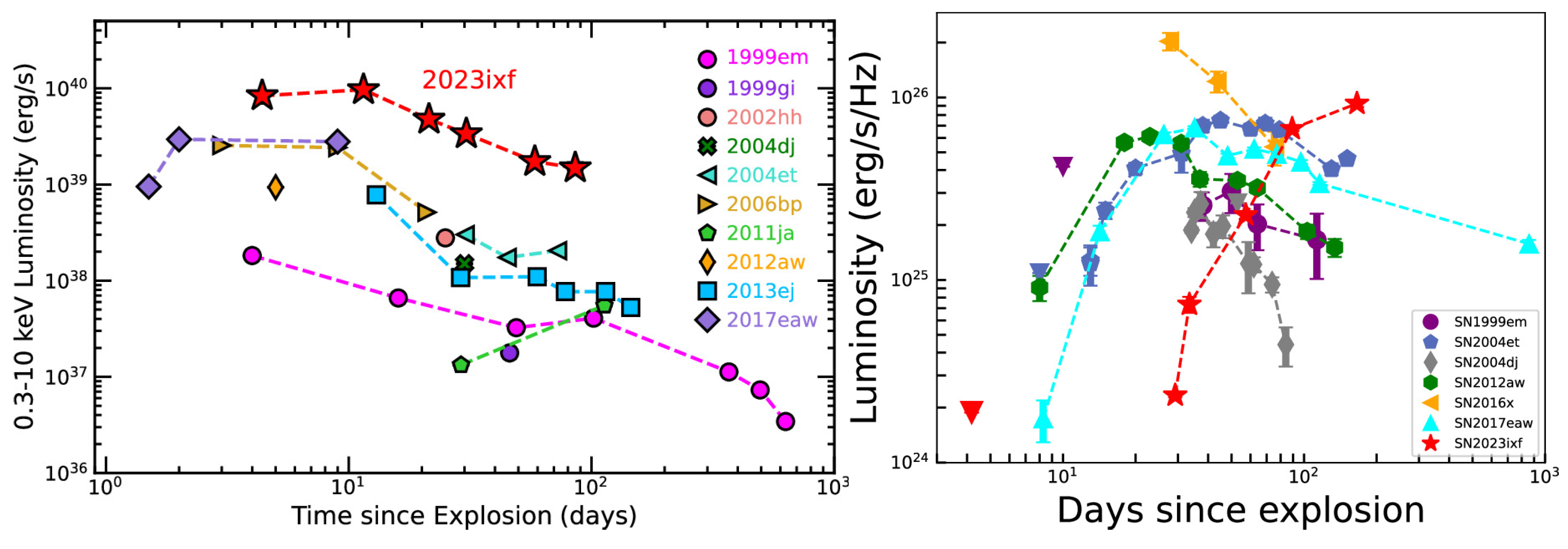
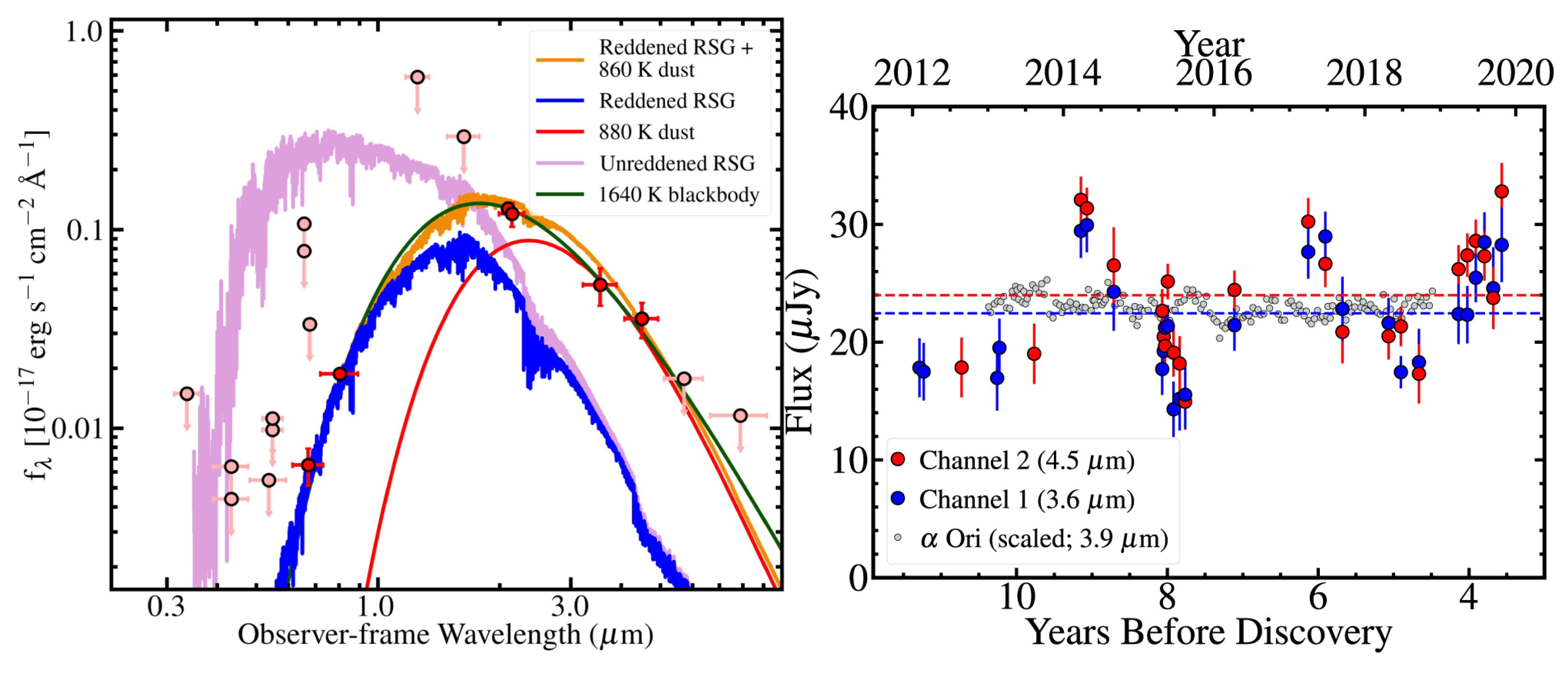
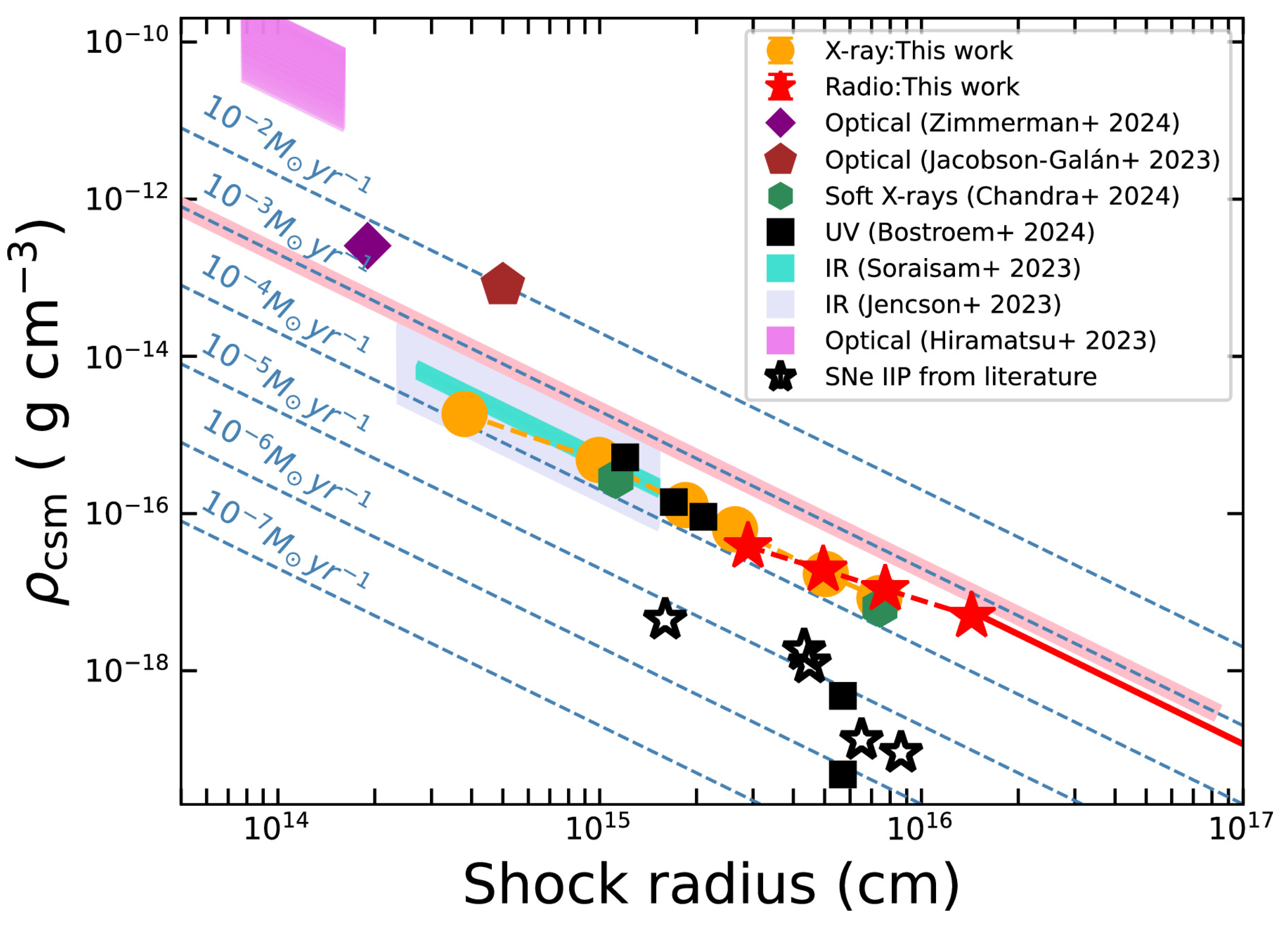
| Ref. | Method | ||||
|---|---|---|---|---|---|
| () | ( ) | (cm) | () | ||
| [67] | Pre-SN imaging | 50 | |||
| [68] | Pre-SN imaging | >4 | 10 | ||
| [69] | Pre-SN imaging | 2 | >2 | 115 | |
| [68] | Pre-SN imaging | >4 | 10 | ||
| [70] | Pre-SN imaging | – | – | ||
| [71] | Pre-SN imaging | – | – | – | |
| [72] | Pre-SN imaging | >1015 | 50 | ||
| [73] | Pre-SN imaging | 8–12 | – | – | – |
| [74] | Pre-SN imaging | 70 | |||
| [75] | Pre-SN imaging | – | – | – | |
| [78] | Pre-SN imaging | 9–14 | 10 | ||
| [82] | LC model | 12 | – | – | – |
| [88] | LC model | 12 | 115 | ||
| [83] | LC model | 10 | 10 | ||
| [34] | LC model | 10 | <5 | 10 | |
| [34] | LC model | 10 | >5 | 10 | |
| [48] | LC model | >17 | 115 | ||
| [90] | LC model | – | 115 | ||
| [10] | LC model | – | 10 | ||
| [49] | LC model | >17 | – | – | – |
| [6] | LC model | – | 100 | ||
| [89] | LC model | – | 75 | ||
| [29] | LC Model | – | 30 | ||
| [65] | LC Model | – | 55 | ||
| [8] | Spectra/LC Model | – | 50 | ||
| [9] | Spectra Model | – | 50 | ||
| [38] | Spectra Model | – | 50 | ||
| [11] | Spectra Model | – | 55 | ||
| [26] | Spectra Model | – | 50 | ||
| [21] | Spectra Model | – | 25 | ||
| [51] | X-ray Model | – | <1015 | 50 | |
| [52] | X-ray Model | – | 115 | ||
| [53] | X-ray Model | – | <5 | <4 | 50 |
| [54] | X-ray/Radio Model | – | 25 | ||
| [58] | Radio Model | – | 115 | ||
| [55] | Radio Model | – | >10−2 | <1015 | 115 |
Disclaimer/Publisher’s Note: The statements, opinions and data contained in all publications are solely those of the individual author(s) and contributor(s) and not of MDPI and/or the editor(s). MDPI and/or the editor(s) disclaim responsibility for any injury to people or property resulting from any ideas, methods, instructions or products referred to in the content. |
© 2025 by the author. Licensee MDPI, Basel, Switzerland. This article is an open access article distributed under the terms and conditions of the Creative Commons Attribution (CC BY) license (https://creativecommons.org/licenses/by/4.0/).
Share and Cite
Jacobson-Galán, W. SN 2023ixf: The Closest Supernova of the Decade. Universe 2025, 11, 231. https://doi.org/10.3390/universe11070231
Jacobson-Galán W. SN 2023ixf: The Closest Supernova of the Decade. Universe. 2025; 11(7):231. https://doi.org/10.3390/universe11070231
Chicago/Turabian StyleJacobson-Galán, Wynn. 2025. "SN 2023ixf: The Closest Supernova of the Decade" Universe 11, no. 7: 231. https://doi.org/10.3390/universe11070231
APA StyleJacobson-Galán, W. (2025). SN 2023ixf: The Closest Supernova of the Decade. Universe, 11(7), 231. https://doi.org/10.3390/universe11070231






